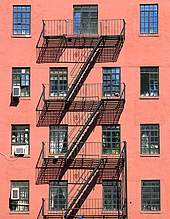Fire escape
The ladder leading from the lowest level of the fire escape to the ground may be fixed, but more commonly it swings down on a hinge or slides down along a track.
An alternative form of rapid-exit fire escape developed in the early 1900s was a long canvas tube suspended below a large funnel outside the window of a tall building.
This escape tube could be rapidly deployed from a window and hung down to street level, though it was large and bulky to store inside the building.
In 1784, Daniel Maseres, of England, invented a machine called a fire escape, which, being fastened to the window, would enable a person to descend to the street without injury.
[citation needed] Abraham Wivell created a variation on the design, including an escape chute, after becoming superintendent of the "Royal Society for the Protection of Life from Fire.
In the 1930s, the enclosed tubular chute-type fire escape became widely accepted for schools, hospitals and other institutions, replacing the open iron ladder type.
[5] However, with the rise of urban sprawl in the mid-20th century, particularly the increase in public housing in cities in the United States and Europe in the 1950s and 1960s, certain problems with fire escapes became clear.
In the poorer areas of several major American cities, such as New York, Boston, Chicago, Cleveland, Detroit, Philadelphia, and Pittsburgh, fire escapes were commonly used for everything but their intended purpose.
The practice of sleeping on fire escapes can also be seen in Alfred Hitchcock's 1954 movie Rear Window (also based on a Woolrich short story), as well as Weegee's photography of the Lower East Side.






